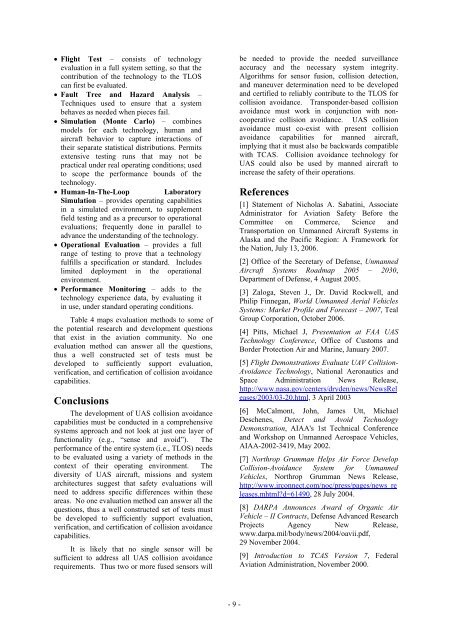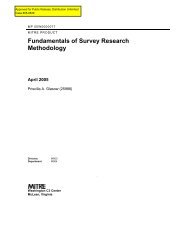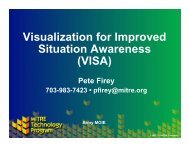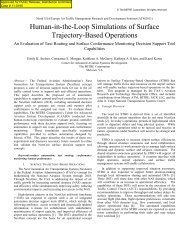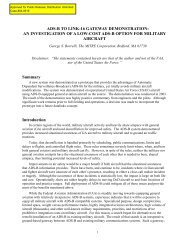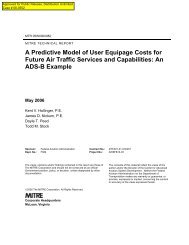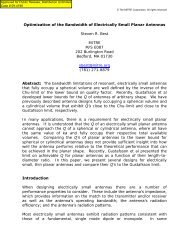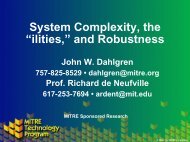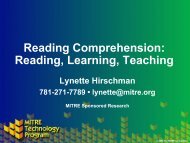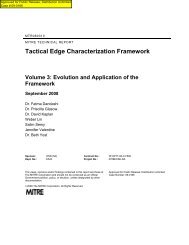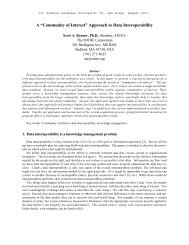Unmanned Aircraft Collision Avoidance: Technology ... - Mitre
Unmanned Aircraft Collision Avoidance: Technology ... - Mitre
Unmanned Aircraft Collision Avoidance: Technology ... - Mitre
You also want an ePaper? Increase the reach of your titles
YUMPU automatically turns print PDFs into web optimized ePapers that Google loves.
• Flight Test – consists of technology<br />
evaluation in a full system setting, so that the<br />
contribution of the technology to the TLOS<br />
can first be evaluated.<br />
• Fault Tree and Hazard Analysis –<br />
Techniques used to ensure that a system<br />
behaves as needed when pieces fail.<br />
• Simulation (Monte Carlo) – combines<br />
models for each technology, human and<br />
aircraft behavior to capture interactions of<br />
their separate statistical distributions. Permits<br />
extensive testing runs that may not be<br />
practical under real operating conditions; used<br />
to scope the performance bounds of the<br />
technology.<br />
• Human-In-The-Loop Laboratory<br />
Simulation – provides operating capabilities<br />
in a simulated environment, to supplement<br />
field testing and as a precursor to operational<br />
evaluations; frequently done in parallel to<br />
advance the understanding of the technology.<br />
• Operational Evaluation – provides a full<br />
range of testing to prove that a technology<br />
fulfills a specification or standard. Includes<br />
limited deployment in the operational<br />
environment.<br />
• Performance Monitoring – adds to the<br />
technology experience data, by evaluating it<br />
in use, under standard operating conditions.<br />
Table 4 maps evaluation methods to some of<br />
the potential research and development questions<br />
that exist in the aviation community. No one<br />
evaluation method can answer all the questions,<br />
thus a well constructed set of tests must be<br />
developed to sufficiently support evaluation,<br />
verification, and certification of collision avoidance<br />
capabilities.<br />
Conclusions<br />
The development of UAS collision avoidance<br />
capabilities must be conducted in a comprehensive<br />
systems approach and not look at just one layer of<br />
functionality (e.g., “sense and avoid”). The<br />
performance of the entire system (i.e., TLOS) needs<br />
to be evaluated using a variety of methods in the<br />
context of their operating environment. The<br />
diversity of UAS aircraft, missions and system<br />
architectures suggest that safety evaluations will<br />
need to address specific differences within these<br />
areas. No one evaluation method can answer all the<br />
questions, thus a well constructed set of tests must<br />
be developed to sufficiently support evaluation,<br />
verification, and certification of collision avoidance<br />
capabilities.<br />
It is likely that no single sensor will be<br />
sufficient to address all UAS collision avoidance<br />
requirements. Thus two or more fused sensors will<br />
- 9 -<br />
be needed to provide the needed surveillance<br />
accuracy and the necessary system integrity.<br />
Algorithms for sensor fusion, collision detection,<br />
and maneuver determination need to be developed<br />
and certified to reliably contribute to the TLOS for<br />
collision avoidance. Transponder-based collision<br />
avoidance must work in conjunction with noncooperative<br />
collision avoidance. UAS collision<br />
avoidance must co-exist with present collision<br />
avoidance capabilities for manned aircraft,<br />
implying that it must also be backwards compatible<br />
with TCAS. <strong>Collision</strong> avoidance technology for<br />
UAS could also be used by manned aircraft to<br />
increase the safety of their operations.<br />
References<br />
[1] Statement of Nicholas A. Sabatini, Associate<br />
Administrator for Aviation Safety Before the<br />
Committee on Commerce, Science and<br />
Transportation on <strong>Unmanned</strong> <strong>Aircraft</strong> Systems in<br />
Alaska and the Pacific Region: A Framework for<br />
the Nation, July 13, 2006.<br />
[2] Office of the Secretary of Defense, <strong>Unmanned</strong><br />
<strong>Aircraft</strong> Systems Roadmap 2005 – 2030,<br />
Department of Defense, 4 August 2005.<br />
[3] Zaloga, Steven J., Dr. David Rockwell, and<br />
Philip Finnegan, World <strong>Unmanned</strong> Aerial Vehicles<br />
Systems: Market Profile and Forecast – 2007, Teal<br />
Group Corporation, October 2006.<br />
[4] Pitts, Michael J, Presentation at FAA UAS<br />
<strong>Technology</strong> Conference, Office of Customs and<br />
Border Protection Air and Marine, January 2007.<br />
[5] Flight Demonstrations Evaluate UAV <strong>Collision</strong>-<br />
<strong>Avoidance</strong> <strong>Technology</strong>, National Aeronautics and<br />
Space Administration News Release,<br />
http://www.nasa.gov/centers/dryden/news/NewsRel<br />
eases/2003/03-20.html, 3 April 2003<br />
[6] McCalmont, John, James Utt, Michael<br />
Deschenes, Detect and Avoid <strong>Technology</strong><br />
Demonstration, AIAA's 1st Technical Conference<br />
and Workshop on <strong>Unmanned</strong> Aerospace Vehicles,<br />
AIAA-2002-3419, May 2002.<br />
[7] Northrop Grumman Helps Air Force Develop<br />
<strong>Collision</strong>-<strong>Avoidance</strong> System for <strong>Unmanned</strong><br />
Vehicles, Northrop Grumman News Release,<br />
http://www.irconnect.com/noc/press/pages/news_re<br />
leases.mhtml?d=61490, 28 July 2004.<br />
[8] DARPA Announces Award of Organic Air<br />
Vehicle – II Contracts, Defense Advanced Research<br />
Projects Agency New Release,<br />
www.darpa.mil/body/news/2004/oavii.pdf,<br />
29 November 2004.<br />
[9] Introduction to TCAS Version 7, Federal<br />
Aviation Administration, November 2000.


